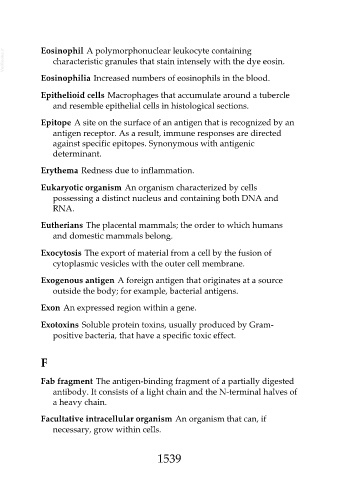Page 1539 - Veterinary Immunology, 10th Edition
P. 1539
VetBooks.ir Eosinophil A polymorphonuclear leukocyte containing
characteristic granules that stain intensely with the dye eosin.
Eosinophilia Increased numbers of eosinophils in the blood.
Epithelioid cells Macrophages that accumulate around a tubercle
and resemble epithelial cells in histological sections.
Epitope A site on the surface of an antigen that is recognized by an
antigen receptor. As a result, immune responses are directed
against specific epitopes. Synonymous with antigenic
determinant.
Erythema Redness due to inflammation.
Eukaryotic organism An organism characterized by cells
possessing a distinct nucleus and containing both DNA and
RNA.
Eutherians The placental mammals; the order to which humans
and domestic mammals belong.
Exocytosis The export of material from a cell by the fusion of
cytoplasmic vesicles with the outer cell membrane.
Exogenous antigen A foreign antigen that originates at a source
outside the body; for example, bacterial antigens.
Exon An expressed region within a gene.
Exotoxins Soluble protein toxins, usually produced by Gram-
positive bacteria, that have a specific toxic effect.
F
Fab fragment The antigen-binding fragment of a partially digested
antibody. It consists of a light chain and the N-terminal halves of
a heavy chain.
Facultative intracellular organism An organism that can, if
necessary, grow within cells.
1539

